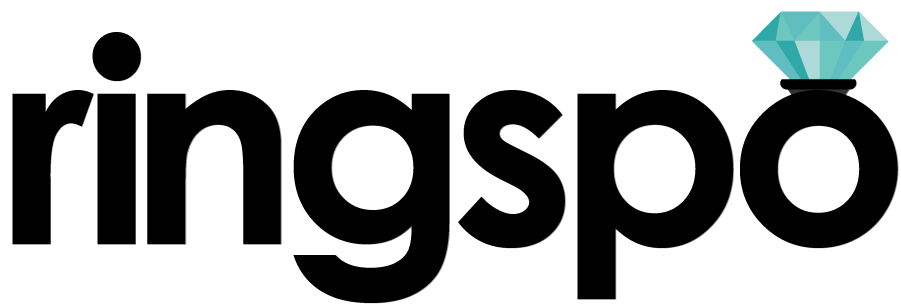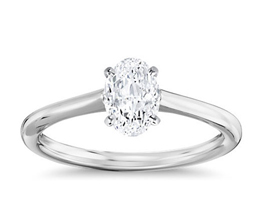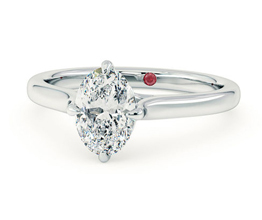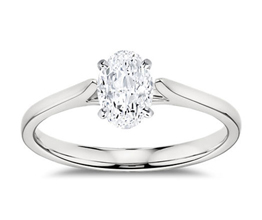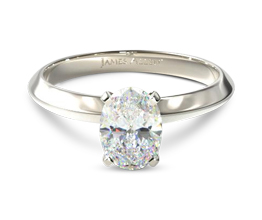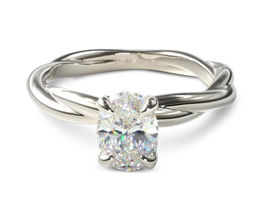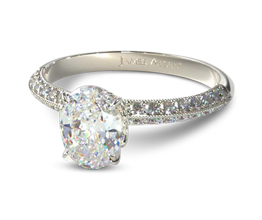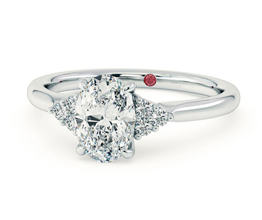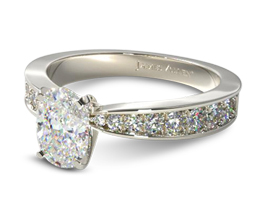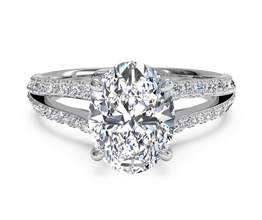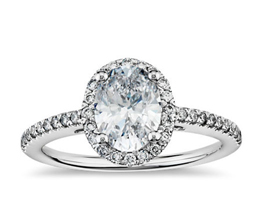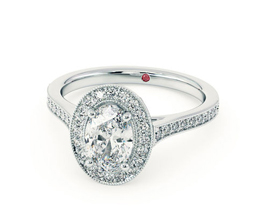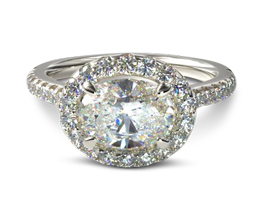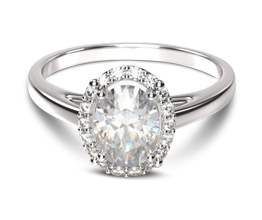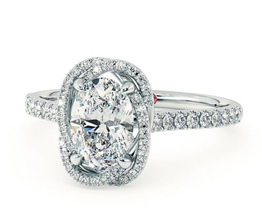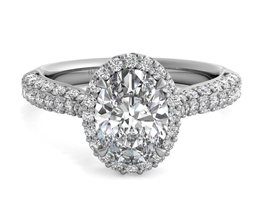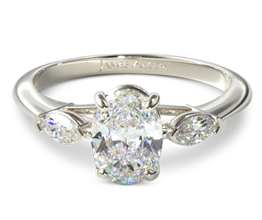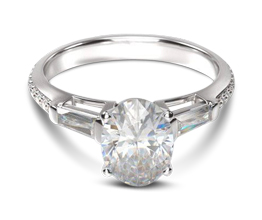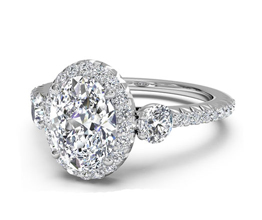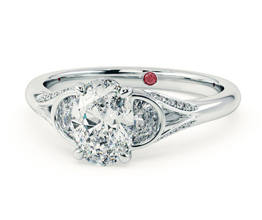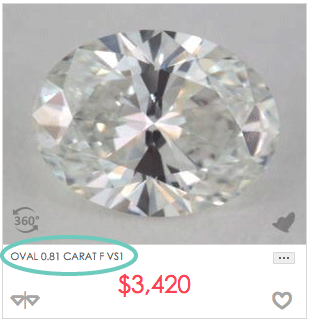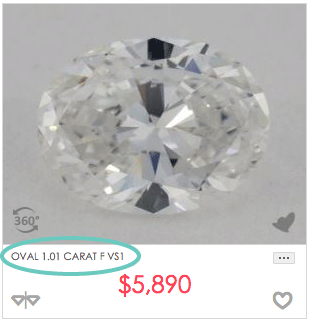Oval diamond buying guide
How to get the most beautiful oval diamond and the best value
Ringspo is reader supported
Ringspo is reader-supported, which means we may receive a commission if you click a link to a retailer & subsequently make a purchase.
We feature links to several retailers to help readers find the one that is the best fit for them. Find out more about how Ringspo works here.
Oval diamond engagement rings are an increasingly popular option for people who want all the benefits of a round brilliant engagement ring (amazing sparkle) but want something a little bit different.
But oval diamonds can be tricky to get right. Many stones are cut to hit a carat weight at the expense of their brilliance and beauty. We want to help you avoid those.
On this page, you’ll learn:
- What’s good about oval diamond rings
- What’s bad about oval engagement rings
- Oval diamond engagement ring setting styles
- An oval diamond buying guide to make sure you get an awesome stone
- Recommended specs for your diamond
Do you know the 4Cs?
Much of the information on this page will focus on diamonds, as getting that right is key to getting an awesome ring for a great price. If you’re not familiar with the 4Cs of diamonds then I’d recommend reading this page which gives an overview of what you really need to know.
Oval shaped engagement rings came about in the 1960s, when a Russian diamond cutter tweaked and elongated the traditional round brilliant shape of diamond.
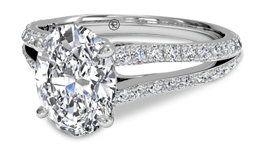
As it’s a variation of the round brilliant shape it includes many of the same features, including 56-58 sides (facets) that are optimized to reflect as much light as possible back to your eye and give excellent sparkle.
There’s no standard shape for oval diamonds – they can be very long and thin, or can be nearly round. But their shape can have a big effect on what how the ring looks on a finger and how much the ring sparkles.
Why Oval Diamonds Are A Great Choice
Oval diamond rings are well-priced
A huge plus with an oval diamond engagement ring is that it is has nearly all the best bits of a round brilliant engagement ring, but is priced much lower. It’s basically an elongated round brilliant, so does an excellent job of reflecting light back to your eyes, making the diamond sparkle brilliantly.
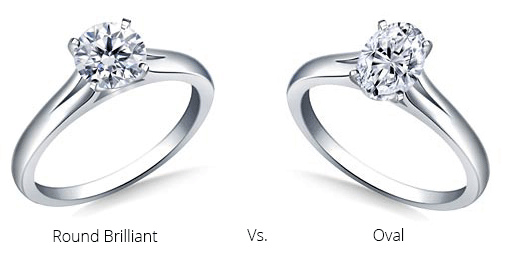
The table below shows the price difference at on of my recommended retailers between a round brilliant diamond and an oval shaped diamond at exactly the same carat weight and quality:
- 1 carat
- Color F
- Clarity VS1
Here’s how they stack up:
| SHAPE | PRICE (US$) | DIFFERENCE (US$) | DIFFERENCE (%) |
| Round Brilliant | 6,610 | ||
| Oval | 4,528 | -2,082 | -31.5 |
That’s over a 30% saving on your diamond, which could be invested into a fancier setting, a larger diamond or just a weekend away with your friends!
The amount saved will always depend on the specific specs that you are looking at, but exact proportion that you save will be dependant on the size and the quality of the stone that you’re looking at, but there will always be a considerable saving available.
Click here to check out today’s prices.
Oval diamonds look large
Oval diamonds are cut shallower than many other stones and this lack of depth means that less of the oval stone is is hidden below the bezel of the ring, where it can’t be seen. Instead, oval diamonds are longer and relatively wide, and this extra surface area contributes to oval diamonds looking larger than most other shapes.
The picture below shows the relative sizes of a 1 carat round brilliant diamond and a 1 carat oval. You can see that that the oval looks larger, even though the two stones weigh exactly the same.
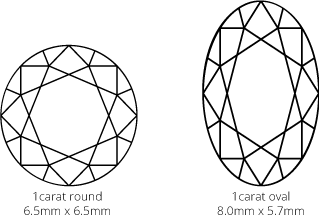
Oval diamonds are flattering
When worn in its traditional orientation, with the oval running lengthwise down the finger, another advantage of the oval shape is that it can be extremely flattering for a shorter finger, making it appear longer and thinner.
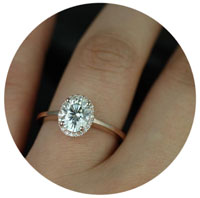
Oval diamonds are easy to wear
Lastly, the round shape has no sharp points or corners, which means that there are no sharp points to snag on anything or to get knocked, which can cause damage. An oval engagement ring is a great choice for a ring that is going to be worn every day.
Things to be careful of with oval diamonds
Oval diamonds exhibit the ‘bow tie effect’
The biggest negative with oval diamonds is the ‘bow tie effect’, which is something that all diamonds that have an elongated shape (e.g. Marquise and pear) share.
The bow tie effect is a dark area that appears in some diamonds when they’re viewed from the above and is a dark area in the shape of a bow tie in the middle of the stone. It’s caused by the facets at the top of the stone not allowing light to be reflected back up through them, giving a dark area.
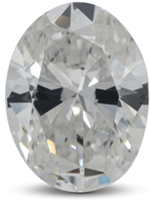
The way to avoid the bow tie effect is to ensure that the stone has been cut well. If a grade has been given to the stone (and they aren’t always for oval cuts) then you should be looking for an excellent or ideal cut.
If no cut information is available then you should look at the length / width ratio of the stone. Ideally this should be between 1.35 and 1.50 to minimise the likelihood of a bow tie effect appearing. If you go any longer than this ie. 1.51+ then you are increasing your chances of a bow tie effect being noticeable
With a poorly cut oval diamond, the bow tie effect can be extremely significant and make your oval engagement ring much less attractive.
Oval engagement ring settings
Oval cut engagement rings come in more styles than most other shapes of diamond, because the oval can either be worn in its traditional orientation of lengthways down the finger, or in the ‘east west’ orientation, with the stone across the finger.
In this section we’ll look at some of the most popular and classic ring settings for ovals. If you’d like to know more about any of the rings then just click through to find out, or click through on the links to check out the whole range of settings styles that are available.
Oval diamond solitaire engagement rings
The simple solitaire oval engagement ring setting lets the most possible light enter the diamond, meaning that it will sparkle to its fullest potential. Larger oval diamonds may have six prongs holding the stone in place, while lighter weights will only have four. Solitaire settings are also the most wallet-friendly style out there.
Scroll across to check out a selection of oval cut solitaire engagement ring options, and click through to find out more about each one.
Oval diamond pavé engagement rings
Solitaire settings leave the center stone to do all of the impressing on its own. A pavé oval engagement ring gives the center stone some additional support, with smaller diamonds mounted on the band of the ring. These diamonds will catch the light at different times to the center stone, adding additional fire and brilliance.
Halo oval diamond engagement rings
A halo oval engagement ring is a great way to add some additional bling to your ring without the expenditure that a big increase in the size of the center stone would incur. Although the ‘setting’ part of a halo ring is more expensive than some simpler ring settings e.g. a solitaire, they can actually save you money as they allow you to go for a smaller center stone while still retaining decent size.
Oval three stone diamond rings
Three stone rings are another good way to add support to the center stone increase the impressiveness of an oval diamond ring. As the oval shape is so long and slim, the added width of the three stone setting can balance out the shape of the ring, without overwhelming the center stone
Oval diamond buying guide
Oval engagement rings are one of the most popular shapes, but even so it’s likely that your local jeweler will have a relatively restricted selection for you to choose from. Online retailers provide a much wider choice of stones and will allow you to find the exact diamond that is right for you.
In this section we’ll look at what you really need to know about the 4Cs of oval diamonds to make sure that you get a great stone for your ring.
Oval diamond cut quality
Unlike round brilliant stones, there are no agreed standards for what makes an ‘ideal’ oval diamond shape. However, there are definitely some guidelines that you should adhere to to minimise the chance of the bow tie effect appearing and maximize the brilliance of the stone.
Oval Diamond Length / Width Ratio
The length / width ratio is super important for oval diamonds because it has a big effect on what the stone actually looks like. A higher length-width ration will mean that the stone will look longer and skinner, while an oval with a lower length-to-width ratio will look shorter, and chubbier.
A length to width ratio of 1.35 – 1.50 is considered the classic oval cut, with the sweet spot within those ratios down to personal preference.
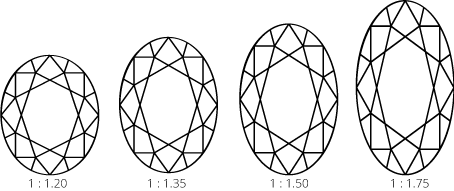
Whatever you do, I would recommend definitely staying below a 1.55 width-to-length ratio, as above this ratio the bow tie effect is more likely to appear.
If you’re going to go for a setting where the oval is flanked by side stones, then consider going with a longer and thinner stone, to allow enough space on the setting for the other stones.
Oval Diamond Depth %
Depth percentage is the ratio of the depth to the width of the stone.
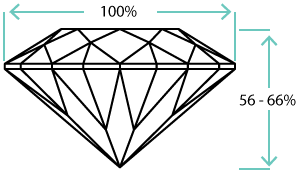
It has a less obvious effect on the overall appearance of an oval diamond compared to some other shapes, but does play a big part in how prominent the bow tie effect is. It can also affect how much light is reflected back to your eyes and therefore how much the diamond will sparkle.
If possible, aim for a depth % within the ‘excellent’ range in the table below:
| Excellent | Very good | Good |
| 56% – 66% | 54% – 72% | 52% – 76% |
The best way to use the above percentages is to enter them into the ‘advanced’ options on online jewelers search tools so that you only see stone that fit within the desirable specs. If you can, try and get ‘excellent’ for both depth percentage and table percentage to ensure that your stone sparkles as brilliantly as possible.
Oval diamond table %
The ‘table’ of a diamond is the large, flat area on the top of the stone. The size of the table in relation to the rest of the stone is important because the table is where the majority of light enters the stone. This needs to be carefully balanced with the other proportions to ensure that the correct amount of light enters the stone to allow for maximum sparkle. A larger table is not always better.
If you can, look for a oval diamond with a table percentage within the excellent range below, to ensure that you get the best sparkle. The ‘very good’ table range will also mean that your diamond will perform well.
| Excellent | Very good | Good |
| 54% – 64% | 52% – 66% | 50% – 68% |
Oval diamond shape
Well shaped oval diamonds have round ends and a ‘full middle’, similar to the stone on the right. It If you can view a picture of the stone, look for evenly rounded ends and a full middle.
The only way to tell the shape of a diamond is to examine the actual stone that you are considering buying. For this reason, I recommend James Allen or Blue Nile, who both have excellent images of each of their diamonds.
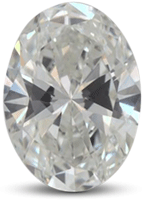
The classic oval shape avoids straight sides or overly pointed ends, like the two stones below. However, if you prefer these shapes, or if the stone is a particularly good bargain, then there is no reason for you to not buy them.
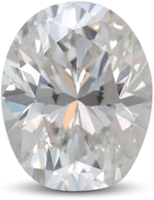
Overly square ends and poor symmetry (top and bottom ends are different shapes)
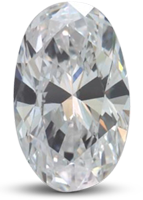
Straight sides and poor symmetry (curve at bottom is not a continuous curve)
Oval diamond color
Most people prefer diamonds that are as white as possible, and if you want your stone to look white then I recommend that you go for color grade G or above. Your diamond will still appear perfectly white when set in a ring, but going lower than this means that there is a possibility that warmer tones may be noticeable.
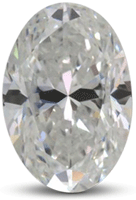
Color E – very white, but also very rare and expensive
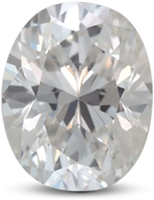
Color G – A great mix of colour and value
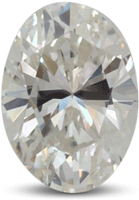
Color I – warmer tones are more easily visible
Oval diamond clarity
Oval diamonds have a larger top ‘table’ (flat area on top of the diamond) than many of the other common diamond shapes, which means that there is a larger window for flaws and imperfections to be seen. As a result I recommend that you go slightly higher on clarity grade than with more compact shapes. I recommend going VS2 or above.
If you are planning on going for SI1, or even SI2 clarity, then again I’d recommend choosing a jeweler who allows you to see magnified images of the exact diamond that you’re considering, so that you can ensure that it’s eye clean. Our recommended retailers all offer this functionality, while many other online jewelers only show stock images of diamonds, which means that you can’t tell whether the individual stone you are considering will be eye clean or not.
Oval diamond carat
Carat weight is something that people often get overly hung-up on. They want to choose a stone with a certain carat weight, even if it means that they end up making sacrifices on other, more important attributes of the ring.
The relationship between a diamond’s carat weight and its visible size isn’t always a direct one. When we judge a diamond’s size, we look at it from the top – known as the ‘face up’ position in the jewelry trade. However, much of the weight of a diamond is actually carried on the bottom half of the stone, where it can’t be seen.
The images below show the difference in size for pear shaped diamonds at a range of carat weights:
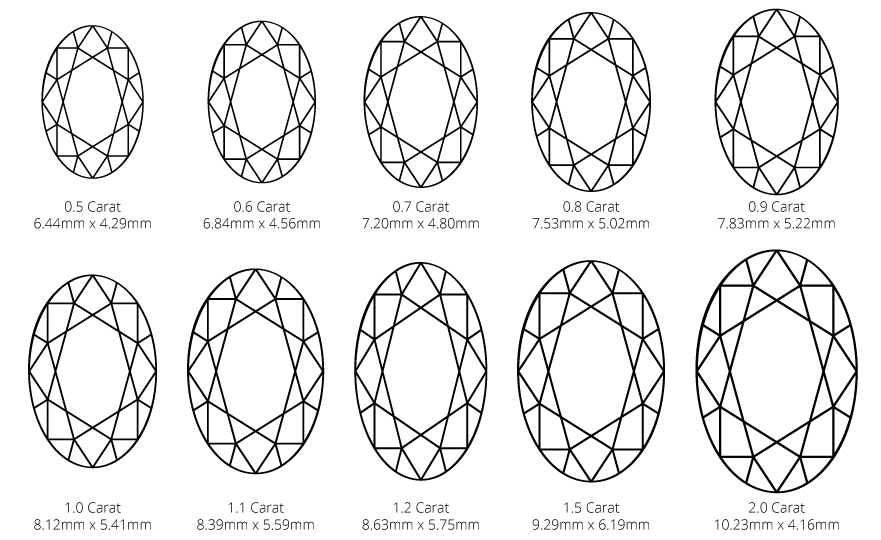
Hopefully you can see that increasing the carat weight doesn’t necessarily translate into a much visibly larger diamond. Changing the size from 0.8 carat to 1 carat is an increase in width of less than 0.4mm – less than 10%. However, the difference in price will be much more significant – over a 70% increase.
The priority that you place on diamond carat weight and how bit you want to go is totally up to you. However, my recommendation is that you definitely don’t make it the most important attribute when choosing your engagement ring. Get the setting you love, find a diamond with a great cut that is going to sparkle brilliantly, make sure that it is eye-clean and has a good color and then see what carat weight you can fit into your budget.
A well-rounded diamond with excellent sparkle will much much more impressive than a big stone with obvious flaws.
Oval diamond certification
The fifth C, and a very important one too. When looking at any diamond, you need to ensure that any diamond that you’re looking at is a ‘cert stone’, which means that it has been assessed, graded and coded with a laser by an independent lab.
Each certificate has a unique report number and detailed information about the stone, covering the four Cs, the height, depth and other info. As well as providing assurance that the stone that you’re buying is the quality that you are paying for, a certificate also proves what you’re buying is not a substitute.
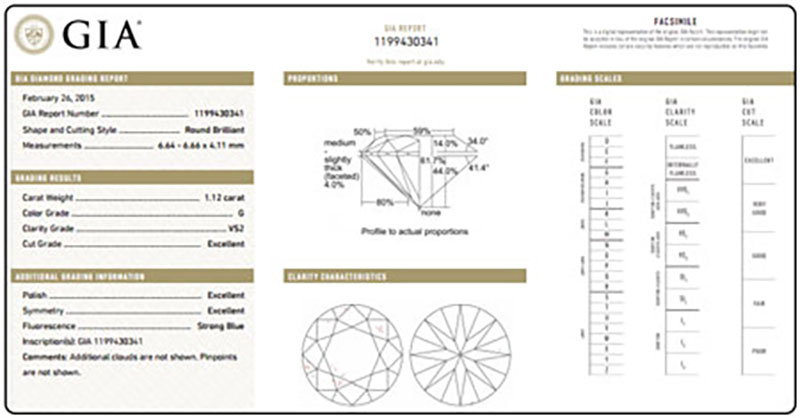
The lab to trust and to look for certification from is the non-profit Gemological Institute of America (GIA). It’s the most internationally recognised and generally seen as the most impartial of all of the gem labs.
The reason that the GIA is so well respected is because most others labs are part of trade bodies that contain jewelry retailers, or are ‘for profit’. While the GIA is very consistent with its gradings, the others have a reputation for being overly generous. What the GIA say is merely a diamond with a ‘good’ cut, maybe be graded ‘excellent’ by another lab, with an excellently large price to match.
Diamond certificates are what makes buying online safe and the best way to get a fantastic diamond at the lowest price. Knowing that each diamond you’re considering has been measured and graded by independent experts allows you to make an informed decision. You can take your time to consider the differences between diamonds and make sure you choose what experts have graded as the best stone, meaning that you get your perfect engagement ring at the best possible price.
Recommended specs for oval diamonds
These specs are the minimum that we recommend to ensure that the diamond on your oval engagement ring looks fantastic.
You can of course go higher than these specs, if your budget allows, but for many of the characteristics you are paying for improvements that are very difficult, if not impossible, to see by the naked eye, especially when mounted in a ring setting.
If you’re unsure about what any of these terms mean, check out this post which talks you through them all.
| Clarity | VS2 |
| Colour | G |
| Cut | Excellent |
| L/W ratio | 1.35 – 1.50 |
| Depth % | 56 – 66% |
| Table % | 54 – 64% |
